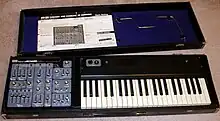| SH-3A | |
|---|---|
 SH-3A with case | |
| Manufacturer | Roland |
| Dates | 1975–1976 |
| Price | UK£400 |
| Technical specifications | |
| Polyphony | Monophonic |
| Timbrality | Monotimbral |
| Oscillator | 1 VCO, 1 White/Pink Noise Generator |
| LFO | LFO1 has sawtooth waveform, LFO2 sine or square and delay slider, Sample-and-Hold with level and sample time sliders. LFO's can be assigned to VCF, VCA, VCO. |
| Synthesis type | Analog Subtractive |
| Filter | Resonant self-oscillating low-pass filter w/ frequency and resonance controls |
| Attenuator | 1 ADSR |
| Aftertouch expression | No |
| Velocity expression | No |
| Storage memory | None |
| Effects | None |
| Input/output | |
| Keyboard | 44 keys (F–C) |
The SH-3A is a monophonic analog synthesizer that was manufactured by Roland from 1975 to 1981.[1] It is unique in that it is capable of both the usual subtractive synthesis and also the less common additive synthesis, offering mixable waveforms at different footages. Two LFOs and a unique sample-and-hold section provided capabilities not found in competing self-contained synthesizers of the time. The SH-3A was Roland's first non-preset based synth. The predecessor, the Roland SH-1000, could also do this but didn't offer as much control as on the SH-3A. The rhythmic pulsing in the Blondie song "Heart of Glass" is an example of its sound.
Contrary to common belief, the initial version "SH-3" did not infringe on the transistor ladder-filter patent of Robert Moog. It used a diode filter like the EMS VCS 3. The SH-3A does use a transistor ladder-filter and as a result can generate Moog-like sounds.
Notable SH-3A users
 Close-up of SH-3A controls
Close-up of SH-3A controls
References
- ↑ Forrest, Peter (1996). The A-Z of Analogue Synthesizers, Part Two: N-Z. Exeter, England: Short Run Press Limited. p. 85. ISBN 09524377-1-6.
- ↑ "Roland SH-3a | Vintage Synth Explorer". www.vintagesynth.com. Retrieved 2018-07-13.